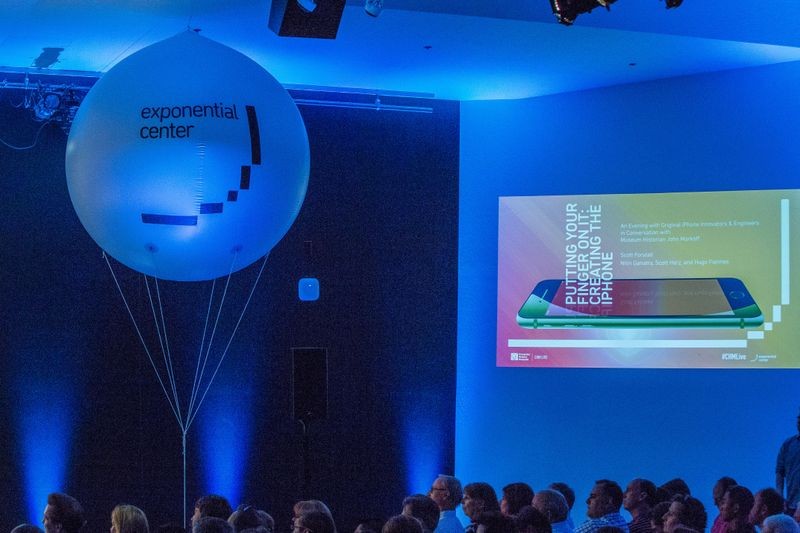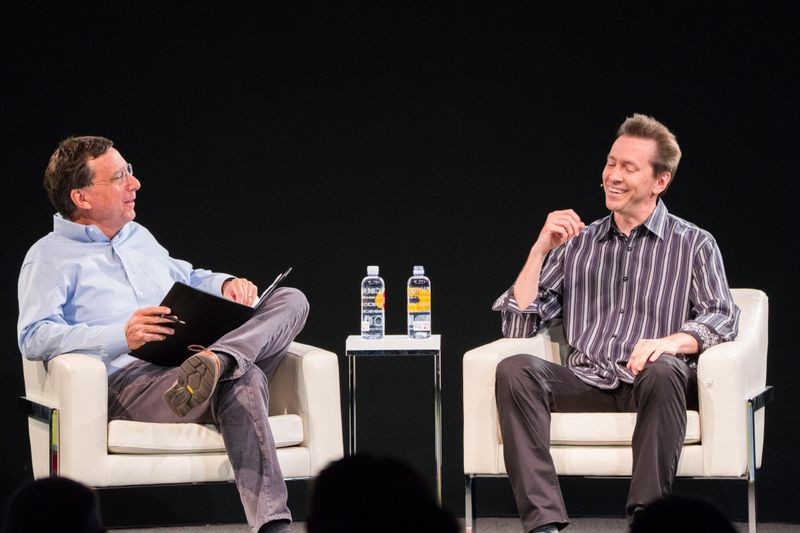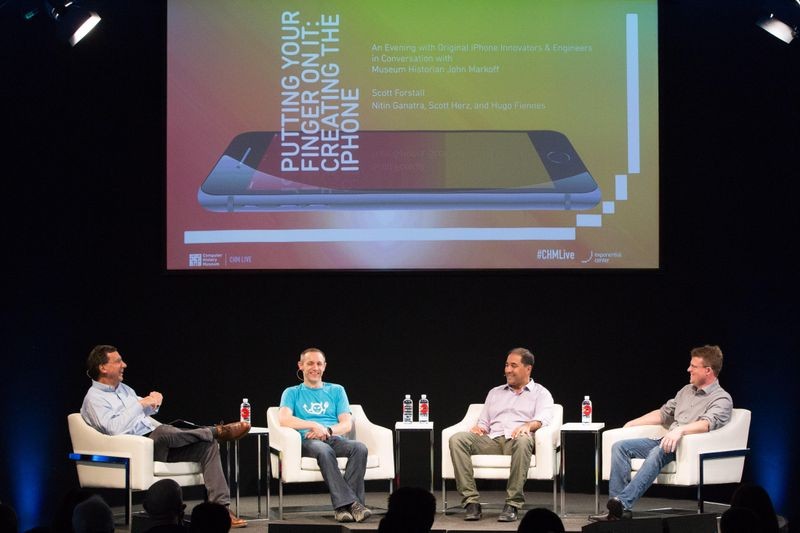

“Putting Your Finger On It: Creating the iPhone—An Evening with Original iPhone Innovators & Engineers in Conversation with Museum Historian John Markoff,” June 20, 2017. Produced by the Exponential Center at the Computer History Museum.
When Steve Jobs returned to Apple in 1997 after it acquired NeXT, he brought with him a close-knit group of engineers. One of them was Scott Forstall, a young software designer who had come to NeXT directly from Stanford University.
Over the next decade-and-a-half, Forstall would become one of Jobs’ most-trusted confidantes and he would be chosen to lead the software design for the original iPhone. Ultimately, Forstall would leave Apple in 2012.
Yet Forstall’s role in shaping the design of the smartphone that would entirely restructure both the computing and communications industries during the past decade cannot be understated. On Tuesday, June 20, he spoke for the first time since resigning from Apple about his work on the iPhone project and his friendship with Jobs.

On the CHM Live stage: Pulitzer Prize-winning journalist John Markoff with iPhone software leader Scott Forstall.
I interviewed him about creating the iPhone in tandem with a companion interview with three key iPhone developers, Hugo Fiennes, Nitin Ganatra, and Scott Herz, as part of the Museum’s Exponential Center iPhone 360 Project, which is exploring the history and impact of the Apple smartphone. In addition to a standing-room-only crowd at the Computer History Museum, the live stream of the evening had been viewed more than 45,000 times when I last checked on Thursday morning.
Unlike many in Silicon Valley Forstall has resisted the pressure to have an immediate “second act.” Instead of pursuing a startup of his own, he turned his attention to an earlier passion that he pursued while growing up in Washington State. With his wife, Molly Forstall, he has become a producer of a Broadway musical and a play, Fun Home and Eclipsed. The two developed a shared passion for acting as high school students, where they also shared the class valedictorian award. The musicals received 18 Tony nominations.
Forstall joked that there were parallels between Broadway and Silicon Valley.
“Every show is like a startup,” he said. “You start with the creative types, you invent something out of whole cloth, you put a bunch of effort and money and time and your life behind it and you give it out to the public and you hope it’s successful and they decide.”
He added that you also almost always lose money.
iPhone software team leader Scott Forstall describes how Broadway is like a startup..
Forstall described how he interviewed at both NeXT and Microsoft after graduating from Stanford, and almost immediately fellow under Jobs’ spell. After a short 15-minute interview, Jobs told him: “We’re giving you an offer and you’re going to accept it!” He did and when Microsoft found out, their recruiter sent him what Forstall described as a “dead fish.” It was actually the Redmond, Washington, company’s attempt to convince him about the quality of life in Seattle, but it backfired. Forstall said it occurred to him that it might actually be a veiled threat—like something from the mob.
Have you ever been surprised during a job interview? Try having Steve Jobs burst into the room. Scott Forstall recalls his interview at NeXT and his first encounter with Jobs..
Forstall described how his work at NeXT had provided a route into the world of user-friendly software design. At Stanford, human-computer interface design was one of the things he focused on, including taking classes from Terry Winograd, the artificial intelligence pioneer who famously turned away from the field to focus on human-centered computer design.
Forstall told a number of stories about working with Jobs. Perhaps the most significant was how Apple’s co-founder decided upon the key technology at the heart of the iPhone —its “multitouch” interface—in an interaction that Apple’s chief executive had with Microsoft engineer who insisted that the software powerhouse was going to reinvent computing around tablet computers ,which used stylus pointing devices. The Microsoft executive insisted that his company had solved tablet computing and they were going to do it with pens, Forstall recalled.
“They were going to rule the world with their new tablets with their pens,” he said. “And Steve came in on Monday and there was a set of expletives and then it was, ‘let’s show them how it’s really done!’”
Jobs believed that the finger would ultimately be the best pointing device, and so he and Forstall went to the computer maker’s hardware team and instructed them to find a way to make it happen.
How Steve Jobs’ encounter with a boastful Microsoft engineer jumpstarted the iPhone project, including its revolutionary multitouch interface. ..
Before interviewing Forstall, I also spoke with the three designers who had worked on building the phone’s hardware, software and designing the user experience.
They each described being contacted to join a new Apple project, which was being initiated with Steve Jobs’ familiar obsession with secrecy. He had perfected the approach when he led the company’s Macintosh development project. Secrecy had the twin benefits of shielding work from competitors while deepening the enthusiasm and interest of customers who by the time the iPhone started were tracking Apple developments with cult-like intensity.
“One day Scott (Forstall) did walk into my office and closed the door behind him and said we’re going to be starting this new phone project,” recalled Nitan Ganatra. “It was both terrifying and at the same time absolutely amazing.” Ganatra made the decision to join on the spot, he said.

On the CHM Live stage, from left to right: John Markoff, Hugo Fiennes, Nitin Ganatra, and Scott Herz.
One of the biggest gambles that Apple made in designing the iPhone was in the company’s decision that eschewing a physical keyboard could be justified by the benefits of a single large screen aided by a virtual onscreen keyboard. Despite great skepticism by industry analysts initially, it soon proved to be an industry-transforming design decision.
Much of the criticism missed the big picture, said Scott Herz, one of the original software designers. “You can get spun up over those kind of problems and not notice that the overall picture is much, much better,” he said.
CHM Live’s “Putting Your Finger On It: Creating the iPhone—An Evening with Original iPhone Innovators & Engineers in Conversation with Museum Historian John Markoff,” June 20, 2017. Produced by the Exponential Center at the Computer History Museum...
The iPhone 360 explores the story of iPhone, from its prehistory, inception, and launch, to its evolution and impact. Coinciding with the 10th anniversary year of the iPhone launch in 2007, iPhone 360 includes integrated initiatives across the Computer History Museum to create new collections of artifacts and oral histories, scholarly research and insights, dynamic events, and educational content and curriculum.
The iPhone 360 Project is part of the Exponential Center 360 series focused on transformational companies and products that have changed the world through technology innovation, economic value creation and social impact. This series supports the Museum’s overall interpretive strategy to explain computing’s history and its transformational impact on our world